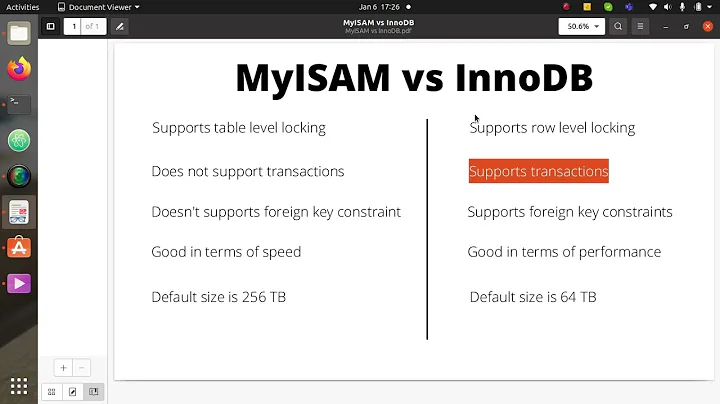MySql: MyISAM vs. Inno DB!
Solution 1
The main difference is that InnoDB supports transactions while MyISAM does not.
There are numerous other differences, however the common one's i am aware of are:
- MyISAM has typically been considered faster at searching, but recent InnoDB improvements are removing this difference and improving high concurrency workload performance
- InnoDB support transactions whilst MyISAM does not
- InnoDB supports referential integrity whilst MyISAM does not
- InnoDB handles indexes a bit differently, storing the primary key as part of every index (making indexes take up more room on the disk, but also making a covering index more likely)
- MyISAM does table level locking while InnoDB can do row level locking
- Different memory/buffer/index settings are used in the MySQL configuration files
- InnoDB is typically said to have better crash recovery
- As mentioned in another answer, the data is store on disk differently. I believe InnoDB is configurable in this area and can have one file per table etc. if required
I'm sure a google search or the MySQL site will bring up numerous other differences in more detail.
Solution 2
InnoDB and MyISAM
Features and Performance comparison:
- InnoDB is newer while MyISAM is older.
- InnoDB is more complex while MyISAM is simpler.
- InnoDB is more strict in data integrity while MyISAM is loose.
- InnoDB implements row-level lock for inserting and updating while MyISAM implements table-level lock.
- InnoDB has transactions while MyISAM does not.
- InnoDB has foreign keys and relationship contraints while MyISAM does not.
- InnoDB has better crash recovery while MyISAM is poor at recovering data integrity at system crashes.
- MyISAM has full-text search index while InnoDB has not.
In light of these differences, InnoDB and MyISAM have their unique advantages and disadvantages against each other. They each are more suitable in some scenarios than the other.
Advantages of InnoDB
- InnoDB should be used where data integrity comes a priority because it inherently takes care of them by the help of relationship constraints and transactions.
- Faster in write-intensive (inserts, updates) tables because it utilizes row-level locking and only hold up changes to the same row that’s being inserted or updated.
Disadvantages of InnoDB
- Because InnoDB has to take care of the different relationships between tables, database administrator and scheme creators have to take more time in designing the data models which are more complex than those of MyISAM.
- Consumes more system resources such as RAM. As a matter of fact, it is recommended by many that InnoDB engine be turned off if there’s no substantial need for it after installation of MySQL.
- No full-text indexing.
Advantages of MyISAM
- Simpler to design and create, thus better for beginners. No worries about the foreign relationships between tables.
- Faster than InnoDB on the whole as a result of the simpler structure thus much less costs of server resources.
- Full-text indexing.
- Especially good for read-intensive (select) tables.
Disadvantages of MyISAM
- No data integrity (e.g. relationship constraints) check, which then comes a responsibility and overhead of the database administrators and application developers.
- Doesn’t support transactions which is essential in critical data applications such as that of banking.
- Slower than InnoDB for tables that are frequently being inserted to or updated, because the entire table is locked for any insert or update.
The comparison is pretty straightforward. InnoDB is more suitable for data critical situations that require frequent inserts and updates. MyISAM, on the other hand, performs better with applications that don’t quite depend on the data integrity and mostly just select and display the data.
Reference: Comparison InnoDB and MyISAM
You can also check it out here for further details: MyISAM Or InnoDB MySQL engine?
Hope this helps.
Solution 3
MyISAM supports (non-standard-SQL) fulltext indexing which InnoDB still does not. This is the only reason we ever use MyISAM today.
Solution 4
The most important difference between MyISAM and InnoDB is that InnoDB supports transactions and foreign keys. If you need foreign keys and related functionality (for example automatically cascading deletes), you will need to use InnoDB.
InnoDB is slower than MyISAM for most uses, but can perform faster in certain conditions due to a better locking mechanism; MyISAM locks the whole table for reading while inserts/updates are executing. InnoDB can do row-level locking, thus allowing multiple concurrent writes and read on the table.
Solution 5
You can have more information about MyISAM & InnoDB in MySQL Documentation:
http://dev.mysql.com/doc/refman/5.1/en/myisam-storage-engine.html
Related videos on Youtube
Comments
-
bhb about 4 years
What are the differences between MyISAM and Inno DB types in MySql?
-
Michel Ayres about 10 yearspossible duplicate of MyISAM versus InnoDB
-
-
 Bill Karwin about 15 yearsRecent improvements in InnoDB performance have eliminated MyISAM's advantages, except in some edge cases.
Bill Karwin about 15 yearsRecent improvements in InnoDB performance have eliminated MyISAM's advantages, except in some edge cases. -
Don Branson almost 15 yearsThis discussion caught my attention while I'm revisiting transactionalessness at eBay: infoq.com/interviews/dan-pritchett-ebay-architecture. Particularly interesting is your comment: "Recent improvements in InnoDB performance have eliminated MyISAM's advantages." I want to bleed more scalability out of my web site, mostly as an exercise. MySQL is the long pole in the tent right now, so I'd like to see a side-by-side performance test, Hibernate+InnoDB (which is what I have right now), vs. SQL+MyIsam. May have to write my own. OTOH, table redesign may be the first order of bus.
-
Jon Black about 14 yearsInnodb for the win ! mysqlperformanceblog.com/2007/01/08/…
-
Jon Black about 14 yearsinnodb_file_per_table dev.mysql.com/doc/refman/5.0/en/multiple-tablespaces.html
-
Seun Osewa almost 14 yearsActually, no. InnoDB is more convenient for backups because it can provide a consistent snapshot of a database without locking every table. mysqldump --single-transaction does this. MyISAM requires you to shut down the database when you're copying the files.
-
jishi almost 14 yearsWhen I said "more convenient" I ment that it is faster, both when dumping and restoring, since you can just copy the datafiles. You don't need to shut down the database, only lock the tables. If you want a consistent copy, then you only need to lock all tables before copying, however it is less intrusive to just lock the table that you are copying. But yes, a innoDB dump would allow the database to be written to during the operation, but a large table can take forever to dump, (several hours) in opposite to a MyISAM file copy which would finish in a matter of minutes.
-
Michael Durrant over 12 years+1 That is a great Ocotober 2011 write-up / update.
-
 bragboy over 12 years@MichaelDurrant: But the content still goes back to sep 2009
bragboy over 12 years@MichaelDurrant: But the content still goes back to sep 2009 -
 Admin over 7 yearsworth noting that InnoDB now supports full text indexing in mysql >= 5.6 for those coming to this post in 2017
Admin over 7 yearsworth noting that InnoDB now supports full text indexing in mysql >= 5.6 for those coming to this post in 2017 -
Michael Nielsen over 6 yearsI made a fresh install of mysql and made a table with ID (key), Name (string) columns. Each insert (through the C interface) took 10ms when the tabel was InnoDB. In MyISAM it took 0.037ms. Writing to a csv with fwritef took 0.007ms. So I think for fast logging MyISAM has superior performance.








